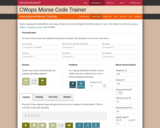
An overview of specificity in CSS.
- Subject:
- Applied Science
- Computer Science
- Computer, Networking and Telecommunications Systems
- Material Type:
- Interactive
- Lesson
- Provider:
- Khan Academy
- Provider Set:
- Khan Academy
- Date Added:
- 04/11/2023

An overview of specificity in CSS.

Using CSS to change size of items.

The Computer Science (CS) for Oregon Plan aims to create rich computer science learning opportunities bydeveloping a shared vision, based on national frameworks and standards to prepare all students, K-12,with computer science knowledge and computational thinking skills necessary to be innovators, creators,and active citizens in our ever-evolving, technology-driven world.
The goals of the CS for Oregon Plan are to create K-12 pathways and roadmaps that provide cohesive,scaffolded learning opportunities to students, focus on inclusion, equity, and access for all, and supportrigorous learning opportunities aligned to workforce needs. Our collaborative, multi-district approachfocuses on creating a clear, concise definition of computer science, understanding the current CSlandscape including barriers and opportunities, evaluating the K12CS framework and its associatedstandards, developing key learning indicators per grade-band mapped to the national framework,connecting educators to aligned resources and associated professional development opportunities,documenting and sharing sample strategies for creating opportunity for all students, and developing andimplementing action plans. As such, the CS for Oregon Plan’s intended audiences are principals,superintendents, STEM/CTE leaders, educators, school counselors, grant managers and foundations, theOregon Department of Education, the Chief Education Office, and legislators. Our advisory group,providing direction and feedback, is comprised of education, non-profit, industry, and state leaders.This work is licensed under a Creative Commons Attribution-NonCommercial-ShareAlike 4.0 International License.

This interactive Morse Code trainer allows you to practice sending and receiving messages in Morse Code. Ham Radio operators may be interested in this tools. There is also a Japanese version.

Brit explains the Caesar cipher, the first popular substitution cipher, and shows how it was broken with "frequency analysis". Created by Brit Cruise.

An overview of calculating results with CASE

Now we'll add a lens to our camera and explore the idea of an f-stop.

Students learn how make phylogenetic trees from morphological data using a variety of candy. Techniques and concepts learned include outgroup analysis, making a character matrix, coding characters, parsimony, building phylogenetic trees, monophyly, polytomy, synapomorphy, and why scientists can get wildly different trees with the same taxa.

Data Carpentry, Software Carpentry, and Library Carpentry are branches under The Carpentries known as a learning program to develop and teach workshops on the fundamental data and coding skills needed to conduct research. Participants can request to host a workshop at their institution or organization, attend a workshop, and/or involve by becoming a certified instructor, contributing in developing the content, or just simply support the programs. All lessons in either Carpentry branch can be used to teach introduction courses in data science/library information sciences.

A two-day introduction to modern evidence-based teaching practices, built and maintained by the Carpentry community.

This book is a guide to Cascading Style Sheets (CSS), a technique widely used in web pages including Wikipedia to describe their visual style and appearance. CSS can take HTML to new places creatively and functionally. Once you learn how to style mark-up, you can additionally learn JavaScript functions that make dynamic web pages.

Find out how hair simulation tools were used in the film the Good Dinosaur.

Use a secret code to decipher a message about Cesar Chavez. Activity from Weekly STEM in a Bag. Colorado Americorp agents in Araphahoe, Denver, Garfield, Larimer, and Weld Counties. Work supported by the Corporation for National and Community Service under Americorps grant number 18AFHCO0010008. Opinions or points of view expressed in this lesson are those of the authors and do not necessarily represent the official position of or a position that is endorsed by the Corporation or the Americorps program. This resource is also available in Spanish in the linked file.

Learn how to use 'chaining', a common technique in jQuery for chaining a sequence of method calls together.

Learn about the Chandra X-Ray Observatory's telescope system, science instruments, and spacecraft system in this interactive activity adapted from NASA.

An overview of Changing CSS classes

An overview of Changing attributes

An overview of changing rows with UPDATE and DELETE

An overview of Changing styles

Although CS Education researchers and practitioners have found ways to improve CS classroom inclusivity, few researchers have considered inclusivity of online CS education. We are interested in two such improvements in online CS education- besides being inclusive to each other, online CS students also need to be able to create inclusive technology.